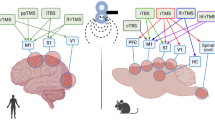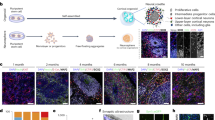Abstract
Brain plasticity refers to the brain’s ability to change structure and/or function during maturation, learning, environmental challenges, or disease. Multiple and dissociable plastic changes in the adult brain involve many different levels of organization, ranging from molecules to systems, with changes in neural elements occurring hand-in-hand with changes in supportive tissue elements, such as glia cells and blood vessels. There is now substantial evidence indicating that new functional neurons are constitutively generated from endogenous pools of neural stem cells in restricted areas of the mammalian brain, throughout life. So, in addition to all the other known structural changes, entire new neurons can be added to the existing network circuitry. This addition of newborn neurons provides the brain with another tool for tinkering with the morphology of its own functional circuitry. Although the ongoing neurogenesis and migration have been extensively documented in non-mammalian species, its characteristics in mammals have just been revealed and thus several questions remain yet unanswered. Is adult neurogenesis an atavism, an empty-running leftover from evolution? What is adult neurogenesis good for and how does the brain ‘know’ that more neurons are needed? How is this functional demand translated into signals a precursor cell can detect? Adult neurogenesis may represent an adaptive response to challenges imposed by an environment and/or internal state of the animal. To ensure this function, the production, migration, and survival of newborn neurons must be tightly controlled. We attempt to address some of these questions here, using the olfactory bulb as a model system.



Similar content being viewed by others
References
Aliotta JM, Passero M, Meharg J, Klinger J, Dooner MS, Pimentel J, Quesenberry PJ (2005). Stem cells and pulmonary metamorphosis: new concepts in repair and regeneration. J Cell Physiol 204(3):725–741
Altman J (1962) Are new neurons formed in the brains of adult mammals? Science 135:1127–1128
Altman J (1969) Autoradiographic and histological studies of postnatal neurogenesis. IV. Cell proliferation and migration in the anterior forebrain, with special reference to persisting neurogenesis in the olfactory bulb. J Comp Neurol 137:433–458
Altman J, Das GD (1965) Autoradiographic and histological evidence of postnatal hippocampal neurogenesis in rats. J Comp Neurol 124:319–336
Alvarez-Buylla A, Garcia-Verdugo JM (2002) Neurogenesis in adult subventricular zone. J Neurosci 22:629–634
Bayer SA, Yackel JW, Puri PS (1982) Neurons in the rat dentate gyrus granular layer substantially increase during juvenile and adult life. Science 216:890–892
Becker S (2005). A computational principle for hippocampal learning and neurogenesis. Hippocampus 15:722–738
Blanpain C, Horsley V, Fuchs E (2007). Epithelial stem cells: turning over new leaves. Cell 128(3):445–458
Cameron HA, Woolley CS, McEwen BS, Gould E (1993) Differentiation of newly born neurons and glia in the dentate gyrus of the adult rat. Neurosci 56:337–344
Cecchi GA, Petreanu LT, Alvarez-Buylla A et al (2001) Unsupervised learning and adaptation in a model of adult neurogenesis. J Comput Neurosci 11:175–182
Clayton H, Titley I, Vivanco M (2004). Growth and differentiation of progenitor/stem cells derived from the human mammary gland. Exp Cell Res 297(2):444–460
Corotto FS, Henegar JA, Maruniak JA (1993) Neurogenesis persists in the subependymal layer of the adult mouse brain. Neurosci Lett 149:111–114
Curtis MA, Kam M, Nannmark U et al (2007) Human neuroblast migrate to the olfactory bulb via a lateral ventricular extension. Science 315:1243–1249
Doetsch F, Garcia-Verdugo JM, Alvarez-Buylla A (1997) Cellular composition and three-dimensional organization of the subventricular germinal zone in the adult mammalian brain. J Neurosci 17:5046–5061
Eriksson PS, Perfilieva E, Bjork-Eriksson T et al (1998) Neurogenesis in the adult human hippocampus. Nat Med 4:1313–1317
Gage FH (2000) Mammalian neural stem cells. Science 287:1433–1438
Gage FH, Coates PW, Palmer TD et al (1995) Survival and differentiation of adult neuronal progenitor cells transplanted to the adult brain. Proc Natl Acad Sci USA 92:11879–11883
Garcia-Verdugo JM, Doetsch F, Wichterle H et al (1998) Architecture and cell types of the adult subventricular zone: in search of the stem cells. J Neurobiol 36:234–248
Gheusi G, Lledo PM (2007) Control of early events in olfactory processing by adult neurogenesis. Chem Senses 32:397–409
Gilad Y, Wiebe V, Przeworski M et al (2004) Loss of olfactory receptor genes coincides with the acquisition of full trichromatic vision in primates. PLoS Biol 2:E5
Gould E, Tanapat P, McEwen BS et al (1998) Proliferation of granule cell precursors in the dentate gyrus of adult monkeys is diminished by stress. Proc Natl Acad Sci USA 95:3168–3171
Ivanova NB, Dimos JT, Schaniel C, Hackney JA, Moore KA, Lemischka IR (2002). A stem cell molecular signature. Science 298(5593):601–604
Johansson CB, Momma S, Clarke DL et al (1999) Identification of a neural stem cell in the adult mammalian central nervous system. Cell 96:25–34
Kaplan MS, Hinds JW (1977) Neurogenesis in the adult rat: electron microscopic analysis of light radioautographs. Science 197:1092–1094
Kempermann G (2002) Why new neurons? Possible functions for adult hippocampal neurogenesis. J Neurosci 22:635–638
Kornack DR, Rakic P (2001) The generation, migration, and differentiation of olfactory neurons in the adult primate brain. Proc Natl Acad Sci USA 98:4752–4757
Kuhn HG, Dickinson-Anson H, Gage FH (1996) Neurogenesis in the dentate gyrus of the adult rat: age-related decrease of neuronal progenitor proliferation. J Neurosci 16:2027–2033
Lafon-Cazal M, Adjali O, Galeotti N et al (2003) Proteomic analysis of astrocytic secretion in the mouse. Comparison with the cerebrospinal fluid proteome. J Biol Chem 278:24438–24448
Laska M, Seibt A, Weber A (2000) “Microsmatic” primates revisited: Olfactory sensitivity in the squirrel monkey. Chem Senses 25:47–53
Li L, Xie T (2005). Stem cell niche: structure and function. Annu Rev Cell Dev Biol 21:605–631
Lim DA, Huang YC, Alvarez-Buylla A (2007) The adult neural stem cell niche: lessons for future neural cell replacement strategies. Neurosurg Clin N Am 18(1):81–92, ix
Lledo PM, Alonso M, Grubb MS (2006) Adult neurogenesis and functional plasticity in neuronal circuits. Nat Rev Neurosci 7(3):179–193
Lois C, Alvarez-Buylla A (1994) Long-distance neuronal migration in the adult mammalian brain. Science 264:1145–1148
Luskin MB (1993) Restricted proliferation and migration of postnatally generated neurons derived from the forebrain subventricular zone. Neuron 11:173–189
Lyngbaek S, Schneider M, Hansen JL, Sheikh SP (2007) Cardiac regeneration by resident stem and progenitor cells in the adult heart. Basic Res Cardiol 102(2):101–114
Marshman E, Booth C, Potten CS (2002). The intestinal epithelial stem cell. Bioessays 24(1):91–98
Martin CM, Russell JL, Ferdous A, Garry DJ (2006) Molecular signatures define myogenic stem cell populations. Stem Cell Rev 2(1):37–42
Miller MW, Nowakowski RS (1998) Use of bromodeoxyuridine-immunohistochemistry to examine the proliferation, migration and time of origin of cells in the central nervous system. Brain Res 457:44–52
Morigi M, Benigni A, Remuzzi G, Imberti B (2006) The regenerative potential of stem cells in acute renal failure. Cell Transplant 15(l):111–117
Morshead CM, Reynolds BA, Craig CG et al (1994) Neural stem cells in the adult mammalian forebrain: a relatively quiescent subpopulation of subependymal cells. Neuron 13:1071–1082
Nakagawa T, Nabeshima Y, Yoshida S (2007). Functional identification of the actual and potential stem cell compartments in mouse spermatogenesis. Dev Cell 12(2):195–206
Nottebohm F (2002) Why are some neurons replaced in adult brain? J Neurosci 22:624–628
Palmer TD, Willhoite AR, Gage FH (2000) Vascular niche for adult hippocampal neurogenesis. J Comp Neurol 425:479–494
Rakic P (2004) Neuroscience: immigration denied. Nature 427:685–686
Ramon y Cajal S (1928) Degeneration and Regeneration of the Nervous System. New York
Reynolds BA, Weiss S (1992) Generation of neurons and astrocytes from isolated cells of the adult mammalian central nervous system. Science 255:1707–1710
Ridet JL, Malhotra SK, Privat A et al (1997) Reactive astrocytes: cellular and molecular cues to biological function. Trends Neurosci 20:570–577
Rouquier S, Blancher A, Giorgi D (2000) The olfactory receptor gene repertoire in primates and mouse: Evidence for reduction of the functional fraction in primates. Proc Natl Acad Sci USA 97:2870–2874
Sanai N, Tramontin AD, Quinones-Hinojosa A et al (2004) Unique astrocyte ribbon in adult human brain contains neural stem cells but lacks chain migration. Nature 427:740–744
Schipke CG, Kettenmann H (2004) Astrocyte responses to neuronal activity. Glia 47:226–232
Schofield R (1978) The relationship between the spleen colony-forming cell and the haemopoietic stem cell. Blood Cells 4(1–2):7–25
Seri B, Garcia-Verdugo JM, Collado-Morente L et al (2004) Cell types, lineage, and architecture of the germinal zone in the adult dentate gyrus. J Comp Neurol 478:359–378
Seri B, Garcia-Verdugo JM, McEwen BS et al (2001). Astrocytes give rise to new neurons in the adult mammalian hippocampus. J Neurosci 21:7153–7160
Shen Q, Goderie SK, Jin L et al (2004) Endothelial cells stimulate self-renewal and expand neurogenesis of neural stem cells. Science 304:1338–1340
Shepherd GM (2004) The human sense of smell: Are we better than we think? PLoS Biol 2:572–575
Spassky N, Merkle FT, Flames N et al (2005) Adult ependymal cells are postmitotic and are derived from radial glial cells during embryogenesis. J Neurosci 25:10–18
Temple S, Alvarez-Buylla A (1999) Stem cells in the adult mammalian central nervous system. Curr Opin Neurobiol 9:135–141
Van Praag H, Schinder AF, Christie BR et al (2002) Functional neurogenesis in the adult hippocampus. Nature 415:1030–1034
Wurmser AE, Nakashima K, Summers RG, et al (2004) Cell fusion-independent differentiation of neural stem cells to the endothelial lineage. Nature 430:350–356
Acknowledgements
We thank Cecile Moreau for help with the artwork. Our laboratory is supported by the Pasteur Institute, the Institut de France (Fundation NRJ), INSERM (Contract # CS0303), Fédération pour la Recherche sur le Cerveau, the Fondation pour la Recherche Médicale, the Agence Nationale de la Recherche (ANR-05-Neur-028-01), the CNRS, the European Neuroscience Institutes Network (ENI-NET; LSHM-CT-2005-019063) and the Groupe Arpège.
Author information
Authors and Affiliations
Corresponding author
Additional information
An erratum to this article can be found at http://dx.doi.org/10.1007/s10735-010-9269-3
Rights and permissions
About this article
Cite this article
Ortega-Perez, I., Murray, K. & Lledo, PM. The how and why of adult neurogenesis. J Mol Hist 38, 555–562 (2007). https://doi.org/10.1007/s10735-007-9114-5
Received:
Accepted:
Published:
Issue Date:
DOI: https://doi.org/10.1007/s10735-007-9114-5




